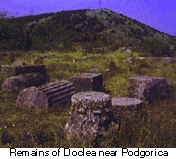Montenegro

Before the arrival of the Slav peoples in the Balkans during the VI century AD, the area now known as Montenegro was inhabited principally by people known as Illyrians. After several punitive expeditions against local pirates, this kingdom was finally conquered by the Romans in AD 9 and annexed to the province of Illyricum.
The division of the Roman Empire between Roman and Byzantine rules-and subsequently between the Latin and Greek churches-was marked by a line that ran northward from (Shkoder) Skadar through modern Montenegro, symbolizing the status of this region as a perpetual marginal zone between the economic, cultural, and political worlds of the Mediterranean peoples and the Slavs. During the decline of Roman power, this part of the Adriatic coast suffered from intermittent ravages by various semi nomadic invaders, especially the Goths in the late V century and the Avars during the VI century. These were soon supplanted by the Slavs, who became widely established in this part of the Balkan by the middle of the VII century. Because of the extreme raggedness of the terrain and the lack of any major sources of wealth such as mineral riches, the area that is now Montenegro became a haven for residual groups of earlier settlers, including some tribes who had escaped Romanization.
The Slavic colonization of the Balkan peninsula, thus, occurred during VI century and probably finished by the middle of VII century. It is believed that predecessors of Montenegrins came from the region (Polablje) between the Baltic Sea and the present-day city of Hanover, Germany (D.Zivkovic, Istorija Crnogorskog Naroda, 1989; R.Rotkovic, Odakle su dosli Crnogorci, 1992; V. Nikcevic, Crnogorski Jezik, 1993). However, Montenegrin predecessors, (known as the Velet and Odobritei tribes) did not come from Germany, since the Germans occupied these territories after Montenegrin predecessors had moved to Adriatic (R.Rotkovic, ibid). Dr Rotkovic collected around 800 toponyms in Montenegro, relating to settlements, rivers, lakes and mountains in Polablje.
 According
to Byzantine tzar Porfirogenit in a paragraph "O Dukljanima i zemlji u
kojoj sada obitavaju" he writes that Doclea (Duklja) belonged first to
Romans and than to Romeji (Byzantium)
According
to Byzantine tzar Porfirogenit in a paragraph "O Dukljanima i zemlji u
kojoj sada obitavaju" he writes that Doclea (Duklja) belonged first to
Romans and than to Romeji (Byzantium)
Thus, coming from the north, Slav tribes settled in the Roman province of Prevalis, where they found the urban Roman and native Illyrian tribes. The Slav people were organized along tribal lines, each headed by a chieftain (zupan). The new arrived Slavs, despite animosity and hostility of native inhabitants, learned to live together, forging Slavo-Romanic modus vivendi and accepting Christianity from the local people. Later, within Byzantine Kingdom, they united their tribes under the name of Scklavinia Doclea (Sklavinija Duklja, or Dukljani) (V.Nikcevic, O postanku etnonima Dukljani, Zecani, Crnogorci, 1987).
